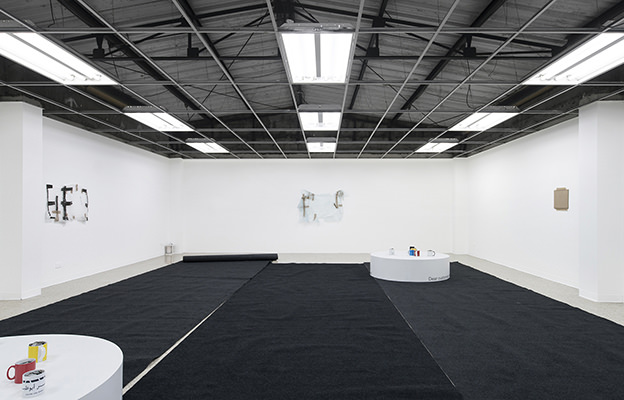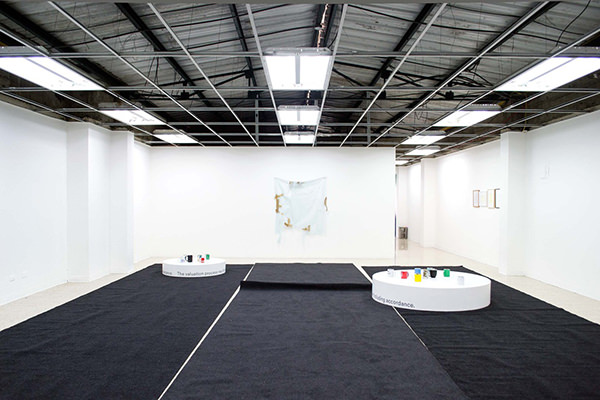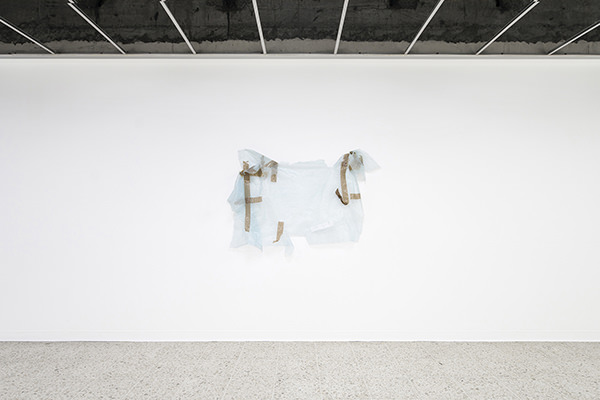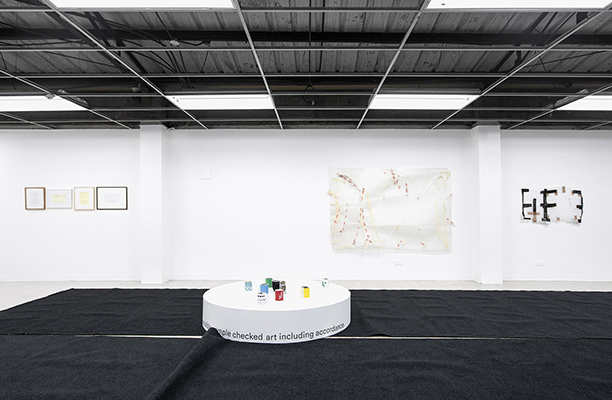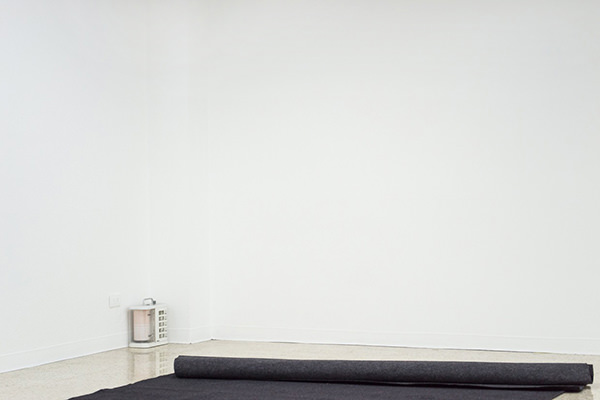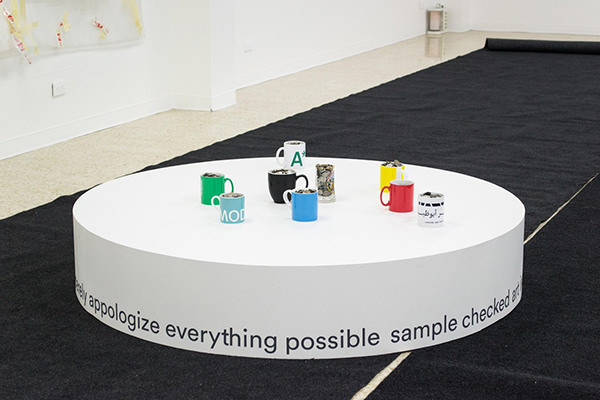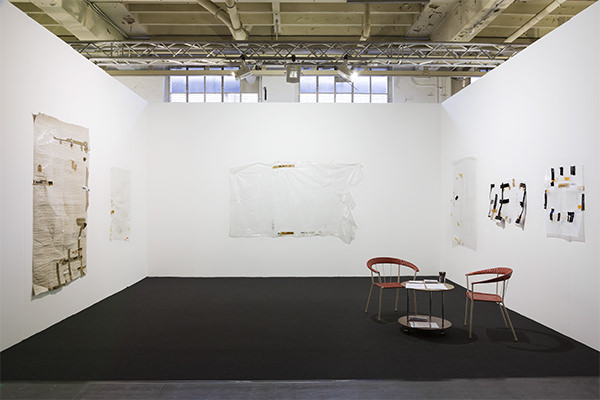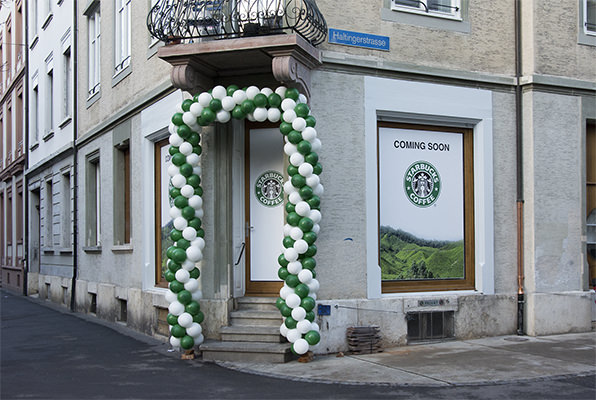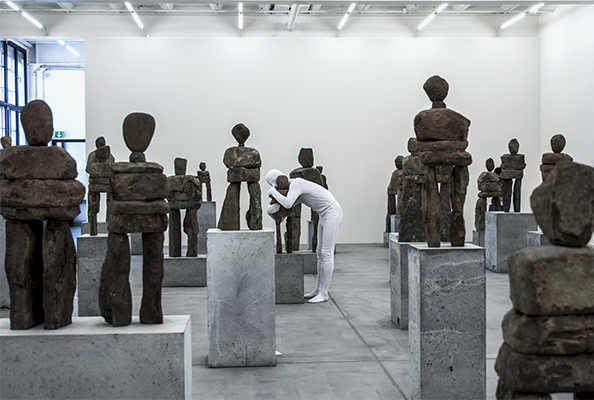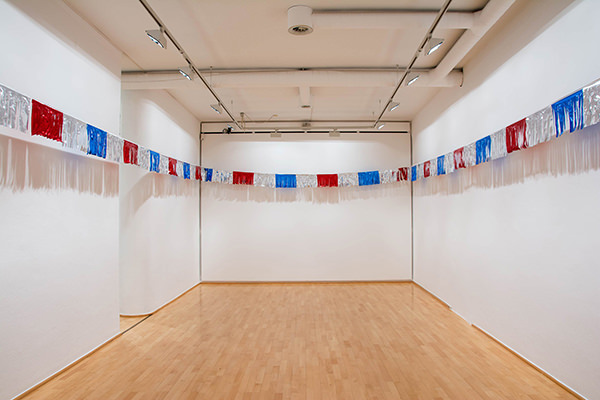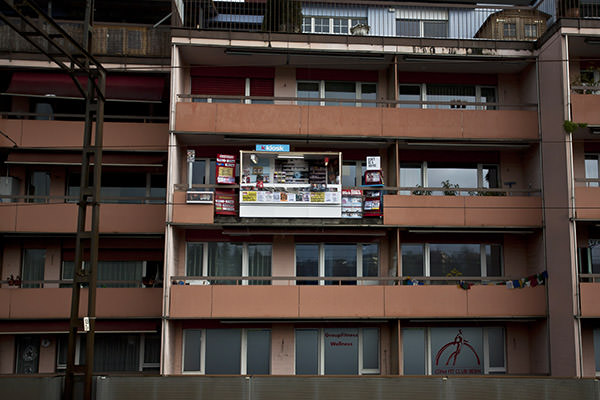From 2016 until 2019, Random Institute ran the curatorial program of the international contemporary art center Despacio in San José, Costa Rica.
This site was coded by Sarvesh Dwivedi and Emmanouil Zoumpoulakis and designed by Sandino Scheidegger.
Heirlooms
With his bold and witty actions, Swiss artist Thomas Moor is translating the legacies of Institutional Critique into the increasingly synthesized world of our time. His projects – from a gallery turned into a fictitious Starbucks branch to a newspaper stand built on the facade of a condominium – are always questioning hierarchies, power, and representation and are therefore investigating alternative understandings of the reality surrounding us.
ThoughtsThoughts
When his actions are directed towards the specific reality of contemporary art and its related fields, languages, communities, and venues , Moor’s investigations are almost epidermal, embracing art conceptually and physically. His exhibition at Despacio, entitled Heirlooms, advances this position further, with a special focus on objects that constitute the syntax of what we can call the “art language.”
A Conversation between Nicola Trezzi (NT) and Thomas Moor (TM)
NT: Looking at your previous projects and exhibitions, I wonder what lead you to develop this kind of language, which is conceptual and ironic, at times monumental and at times ephemeral and invisible. Can you tell me what you studied in Zurich? Did you develop this language already in school? If you did, who was your greatest influence there? I also would like to know about your childhood. Did you grow up in an environment that was friendly to art?
TM: I grew up in a small village in Fricktal, a hilly rural area in the north of Switzerland in a teacher family that cultivated a high interest in science and classical music. While playing Cello all my childhood and teenage years, I’ve entered contemporary fields of culture through Hip Hop. Contemporary art as such I’ve experienced more through a touristic lens, as my parents would take the kids to museums on city trips or so. In that way, it wasn’t a part of my home or so. I’ve left the place to study communication theory and art history at the University of Zurich, though within the first year I’ve quit to apply for art school, more or less after learning about Gordon Matta-Clark and Andrea Fraser.
Currently I’m in the MFA program at the Zurich University of Arts, so yes. I’ve never studied arts under one “master” or so, so there are multiple influences automatically. I guess influencial for me in the BA in Zurich were Maria Eichhorn, Bea Schlingelhoff and San Keller (though I’ve never studied with him).
NT: How did you find yourself in this field and when was the first time you called yourself “an artist”?
TM: The term “artist” I’ve initially tried to use simply as a description of a political, philosophical, economical position. Therefore it has been a very flexible term for me, anyone and anything could be an artist. I’ve always tried to simply think it as a very loose, open function, rather than a hierarchically achievable status. But at the moment I’m not so concerned with it anymore.
NT: Playfulness and irony play a very important role in your work; how do you feel regarding this association? Do you see your work as playful and ironical? If so, what do you think is the work that most precisely encapsulates this association?
TM: Hmmm… I think my work usually tries to bend and stress power structures from within. I often work with certain existing elements, which I try to deconstruct and re-discuss through small shifts. This makes “play” one of the main gestures in my practice. Irony seems like a much more specific aspect, that is, if it occurs in my work, more of a side result that I wouldn’t want to strategize. Art that’s simply ironic as its main purpose is often rather boring.
NT: Bending and stressing power structure from within seems a very appropriate way to describe your work; can you mention specific projects, yours and by artists you admire, that you think encapsulate this strategy at its best?
TM: As an example of my work I would choose the Astroturfs (2015). Here I’ve commissioned two astroturfers (people who write “fake” online reviews. 25% of all Yelp reviews are filtered, suspected to be fake or unhelpful according to www.fortune.com, 2013) for 10$ each to write fake reviews on OLM space, the exhibition space I was doing the project at.
They both have come up with a very personal, completely fictional review of an experience at this space, describing a portrait exhibition and the apparently wonderful garden area. One of the two reviews has remained unfiltered and has so far been the only Yelp review on OLM space. Examples of works by other artists would maybe be Angus Fairhurst’s Gallery Connections (1991-1996), for which he prank called different London galleries by calling two at the same time and then connecting their lines, or also, in a more technical way, Karin Sander’s Mail Paintings (since 2004), which are more or less blank canvases that were shipped around unpacked to create a patina solely by its shipping.
NT: Some of your projects, such as Trojan Horses (2016) and Cargo Veils (since 2015), echo conceptual art and institutional critique; at the same time their different DNA – both conceptually and formally – create an interesting “in between space”. In other words, the path we make from a gallery space turned into a fictitious soon-to-open branch of Starbucks to a series of bi-dimensional ‘paintings’, which are in fact bubble wraps used to pack artworks by John Baldessari and Daniel Spoerri among others, is quite wide and yet logical. How do you justify this versatility?
TM: Versatility doesn’t have to be justified in my opinion. What is more important to me is this “in between space”, like the in between of a rug and a carpet. Comparing those two works, first, Trojan Horses was a collaboration with Florence Jung for a specific event, the opening of an art space, while the Cargo Veils series I’ve started approximately a year ago during an art handling job I was doing for someone else, and has been a continuing project ever since.
I think both mentioned projects work towards a loose analysis of the “agents” of public relations. This drives me through different media, but also through different aesthetics.
Depending if I’m working with features of public relations of the gentrification process of a neighborhood, or if I’m working with art handling features, I appropriate aspects of their aesthetics to create a playground to be tipped over. Another example for a field, like the here engaged fields of lifestyle brands and relics of the logistics of art, I’m very much interested in is cash money, as cash money offers a variety of representational features that have been translated into physical materials, and their physical and contextual representational features start melting together, but at the same time become brittle and pathetic.
NT: I’d like to speak more about this “in between”; can you extend it to reality at large? Can you name “in between situations” that are inspiring to you? Can we create these situations, and how? I’m very curious to understand how we see this outside the field of art.
TM: Hmmm… We could look at Freeports. I don’t mean it only as an example of being “in between” because of it being a (hopefully) temporary station between A and B, but because of the anonymous, standardized, physical state of a good inside a Freeport, that through being there becomes 100% dependent on its documentation, even though (or rather, because) its physical features are supervised and secured to an extent that turns this good transparent, almost invisible, in the most inaccessible, deep frozen way. This might not sound like an outside the field of art-example, but I think it’s easily applicable to other fields within, let’s say, contemporary logistics.
NT: Your practice often employs outsourcing: from Craigslist – through which you found two writers to whom you commissioned fake reviews of LACMA – to Yelp – a portal that, among other services, publishes crowd-sourced reviews about local businesses but also space for art and culture, like LACMA, where the two aforementioned fake reviews were published. Can you speak about this aspect of your practice?
TM: In the beginning of art school I was very curious about outsourcing as a mode of art production. But by now I doubt that outsourcing as such is very specific for my practice. I feel like outsourcing is the process of handing over labor to external work force, usually for economic reason. But in my case, I fully depend on the specific touch of the specific laborer I’ve “hired”, and the work would be a completely different one if I would do it myself. It’s more an interest in this random factor, which is highly anonymous, yet highly personal at the same time.
NT: When you say “highly anonymous, yet highly personal” you seem to follow a position that is driven by oxymora. Can you give me more examples? How do you manage this double take into your work?
TM: I think the oxymoron is essential for my work. I’m very curious about situations that manage to exist in (or because of) a constant interior tension. To play with these oxymora, to confront their two extremes, creates a vibration that makes up some of the energy of my work. For example, in Touching Tangibles, I maneuver ultimately on the physical surface of the sculpture, but simultaneously I’m touching the contextual surface of the sculpture, as I undergo the procedure to legally perform my act of hugging, which leads me through conservational aspects, photo rights, and also the sheer moods and patience of artists and art professionals, who didn’t really want anything from me, but the other way around.
I think the investigation of this contrast of “Hardware” and “Software” circles around a lot of questions concerning current understandings of material and knowledge, in which production and capital isn’t defined through resources anymore, but through the dynamics of its logistics.
NT: And why do you think your initial interest in outsourcing has faded?
TM: I think one reason, why my initial interest in outsourcing has faded, has for sure been some experiments within this field. For one of my first projects in art school, A Series of Portrait Paintings (2011), I’ve taken portrait photos from my circle of artist friends. Then I ordered oil paintings depicting those images in Dafen, China. Dafen is a suburb of Buji, Longgang, Shenzhen in Guangdong province, China. It is the worlds largest production place for oil painting copies. According to Wikipedia (2011), there are approximately 10‘000 people working in over 300 different painting workshops. They paint as piece workers mostly copies of European art history masterpieces as well as paintings from sent in photographs. Each year Dafen exports about 5 million paintings, main clients are European and American hotel chains and warehouses.
So this project was very much concerned with outsourcing. In the aftermath, there were some aspects I wanted to be more careful with in the future. It seemed like a too easy way to hide behind containers, and to wrap my head around painting or even drawing after this project wasn't very easy. Another reason might be, that in the last five years cultural production in general (or maybe just my production) is touching outsourcing moments less as a statement, but more and more just as an absolutely common mode of production somewhere between "shareconomy" and collective memory, sampling and more precarious forms of recycling.
NT: Going back to institutional critique, there are two works that I believe take the legacy of this moment in the history of art in order to ‘charge’ it with a sentimental and emotional touch. The first one is Touching Tangibles (2013-2014), a performance, in which you are completely covered by a white cotton body suit – a reference to the white gloves used by professionals to handle works of art – hugging artworks by artists such as Jeff Koons and Ugo Rondinone, in venues such as the Kunstmuseum Basel, Galerie Eva Presenhuber as well as private collections. The second one is Mood Painting (2014–ongoing), in which you create wall paintings appropriating wall colors used in museums; each color is first scanned and then recreated by a paint shop. Beside the art historical reference, what interests me in these two works is their immateriality: while the first one implies a very intimate encounter between the performer and the artworks that we can only experience through photo documentation, the second one can basically exist anytime and anywhere. What is your position regarding these two works?
TM: Those two pieces I’ve actually worked on more or less at the same time. The Touching Tangibles series has been an experiment that only could happen during my BA when I knew practically nobody in the art scene. Each hug has been organized in advance with the exhibitor and sometimes the artist, sometimes the conservator. As I didn’t know most of the people to be involved in this project personally, I’ve tried to always use the info@...-entrance to the institutions, a communication tool that suggests an open loophole channel from and to the public. I didn’t want to organize this as “the artist”, but just as a random stranger from the Internet. A lot of institutions also didn’t answer my request. The way I’ve rematerialized the performance is a single channel slide projection showing the 30 hugs documented with one slide each. This antiquated, archival, a bit noisy way of presentation reintroduces a sense of performativity into the process of exhibiting the project. The dimmed light is equally important as the dust floating around in the projection for this reinterpretation of the sacred, yet goofy moment of the performance. Even if the Mood Paintings can exist anytime, anywhere, they depend in a way just as much on an active focus on them as Touching Tangibles. Or better, their initial purpose was to introduce this active focus into the process of experiencing any painted wall as wall painting and vice versa, the in-between space of painted walls and paintings.
What interests me about their ambivalent immateriality comes maybe from the general tendency of declaring and contracting in the art system, which Hito Steyerl partially describes in her lecture Duty-Free Art. In its third chapter - titled Conditions of Possibility - she opens up an analysis on freeport art storage, its political conditions, economical functions, and, them playing a huge role in the contemporary art market, dangerous impacts on art production.
NT: Another important element of your practice is the symbolic value and official function of certain materials; your work has been created with high security paper, streamers that are used in American car dealerships and your upcoming project will feature a fair carpet. The captions of your work reveal how important the symbolic value and official function of these materials are to you. Can you explain why?
TM: Actually I think it’s exactly not the symbolic value, but the actual material that interests me. For example, the Mandalas, the high security papers, are kind of stock guilloches for which you have to register to acquire, to then turn them into certificate papers or so, in this initial form, or altered. But I wanted just to register and acquire a set of 40 different papers, and they now literally are drawings and certificates.
With the car dealership streamers I’m trying to clash two different kinds of space contracts, a bit like a low-fi version of Carey Young’s Declared Void (2005). In terms of symbolic value, I’m just more drawn to using Amazon and such as a production platform, rather than representing this object with another symbol.
The fair carpet is again another example. Here, a material that seems familiar with spaces for the art market - and contemporary event culture in general - is isolated and re-appropriated. With playing with its original codes, and kidnapping them partly into my exhibition, I’m trying to walk a tightrope, where the carpet could at any time turn into part of the architecture, or into a stage, or into a displayed object itself.
I guess generally, I’m trying to avoid adding another representational layer to my work to discuss power structures, and this is what leads me to work with these specific materials and contexts.
NT: Isolation, re-appropriation, representational layer… you seem to have a clear vocabulary; can you say a bit more about each of these fascinating terms?
TM: Isolation I see for example as one of the common grounds between the white cube (or the museum) and the prison, exhibiting and imprisoning: focusing on the tension between the object and the surrounding architecture by trying to eliminate everything beyond those two elements. Just like the disciplining of the classic bourgeois museum, educating the public to be humble and have faith in authority, the prison also has its aesthetic communicators to the "viewers" as a deterrent. Re-appropriation in this context I see my and others' notion of working with appropriated aesthetic codes in a world after Institutional Critique, Appropriation Art, or Pop Art, but also after the rise of massive corporate involvement in cultural events, where (partly appropriated) "art imagery" is used in the branding of such corporations, and so on.
With another representational layer I mean the moment, when I decide to work with, let's again say, money bills, and I decide to copy this money bill onto some sort of medium that is leaving the material of the money bill, which is for example that happens in digital photography, or any other form of depiction. I prefer a good example over an ideal depiction.
InformationInformation
The exhibition runs from July 28th until August 20th 2016 at Despacio in San José, Costa Rica. The opening takes place on July 28th from 6pm - 9pm at Despacio. (FB Event)

